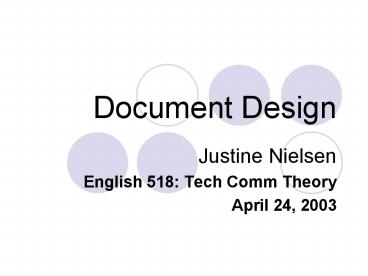Document Design - PowerPoint PPT Presentation
1 / 28
Title:
Document Design
Description:
Document Design. distinguishes things that are different from one another and ... programming, graphic design, user interface design, visual interactive design... – PowerPoint PPT presentation
Number of Views:69
Avg rating:3.0/5.0
Title: Document Design
1
Document Design
- Justine Nielsen
- English 518 Tech Comm Theory
- April 24, 2003
2
Document Design
- Analyze your audience
- Determine appropriate information architecture
and medium - Design for use
- Select effective design tools
3
Analyze Your Audience
- Reconsider your audience
- Who are they?
- What do they want or need?
- How will they use the material?
4
Analyze Your Audience
- Who is your user?
- Technical ability
- Interest in the subject
- Translation needs (language options)
More to come at Jen and Ryans May 1st
presentation onGlobalization Issues
5
Analyze Your Audience
- What is your users goal?
- Complete a task
- Solve a problem
- Make a decision
6
Analyze Your Audience
- How will they use the document?
- Location
- Duration
- Motivation
7
Analyze Your Audience
- Become a user advocate
- Firsthand knowledge is best Whenever possible,
learn the procedure or use the product yourself - Test usability Speak with or observe users of
the product or document (find something similar
if the original is unavailable)
8
Analyze Your Audience
- User advocates design documents
- to help readers quickly and easily find accurate
information. - to be used (skimmed), not read.
- to make the process seemintuitive effortless.
- to help users do their work.
9
Information Architecture and Medium
- Which medium is most appropriate?
- Do I need more than one medium?
- Do I need more than one version?
- Do I want to use dynamic design, or can I get by
with static content design?
10
Information Architecture and Medium
- Which medium is most appropriate?
- Online
- Other
- All of the above, a.k.a. Single-Sourcing
11
Information Architecture and Medium
- Online
- Layer information to serve a variety of users,
disclosing ideas hierarchically - Simple, brief explanations are best for novices
- Experts may require additional detail
- Effectiveness derives in part from both the
online page or sites design structure and from
its information content - Test with various technologies, not just
bleeding edge versions
12
Information Architecture and Medium
- Consider physical workplace conditions when
determining page size, substrates, and graphic
elements (page layout, fonts, colors) - Index specific, rather than inexact, terms
13
Information Architecture and Medium
- Other document formats
- Electronic file (PDF, Excel, raw data)
- Other
14
Information Architecture and Medium
- Single-Sourcing
- Content databases (like FrameMaker) quickly
generate multiple versions in different media
with varied contentand for different users
15
Information Architecture and Medium
- Document Design distinguishes things that are
different from one another and connects things
that are related to one another.
16
Information Architecture and Medium
- More to come
- at Brads June 5th Information Architecture
presentation
17
Write for Use
- Make information easy to find
- Just chunk it!
- Keep it short (words, sentences, lists,
procedures) - Employ long paragraphs (3 sentences) only for
explanation, not for instruction - Use jargon judiciously and appropriately
- Use repetition rather than cross-referencing
18
Write for Use
- and easy to understand
- Use direct writing style
- For instructions, begin each step with an action
(verb?) and identify the expected response - Generate scenarios and analogies to clarify
content - Exemplify
19
Write for Use
- Lists and Procedures
- Online Maximum 7 items
- Print Maximum 9 items
- Procedure too long?
- Break it down into several steps or consolidate
steps
20
Select Effective Design Tools
- Use text organizers
- Design for visual effectiveness
- Include accurate and relevant technical
illustrations
21
Select Effective Design Tools
- Use Text Organizers
- Headlines
- Kickers
- Subheads
- Headers and footers
- Pull quotes and sidebars
- Bulleted and numbered lists
22
Select Effective Design Tools
- Design for visual effectiveness
- Combine words, images and shapes to create a
visual language - Clarify abstract or difficult concepts with
graphics - Use visual elements (fonts, paragraph spacing,
colors, graphics) consistently - In a diagram, use shading or boxes to clarify
relationships
23
Select Effective Design Tools
- Design for visual effectiveness
- Dont overwhelm readers with too much information
- Create tables and diagrams break those down into
simpler, multiple graphics - Provide ongoing motivation for readers design
for interest, access, and impact - Make it memorable
- Avoid intimidating your reader
24
Select Effective Design Tools
- Include accurate and relevant technical
illustrations - Avoid distortion, deception, and
misrepresentation
25
Select Effective Design Tools
- Include accurate and relevant technical
illustrations - Remove distracting chart junk
26
Select Effective Design Tools
- Include accurate and relevant technical
illustrations - Use appropriate file format (.jpg, .gif, .tif)
to produce quality images with the appropriate
screen or output resolution - Create online images that load quickly
27
The Bottom Line
- Why do I need to know this stuff?
- Provide the total package
- Technical communicator vs. writer
- How can I market my design skills?
- Audience analysis, task analysis, verbal
communication, interpersonal and investigative
skills, computer programming, graphic design,
user interface design, visual interactive design
28
The Bottom Line
- How could I
- best exhibit these skills to a prospective
employer? - See you June 4th
- for our Digital Portfolio session!































